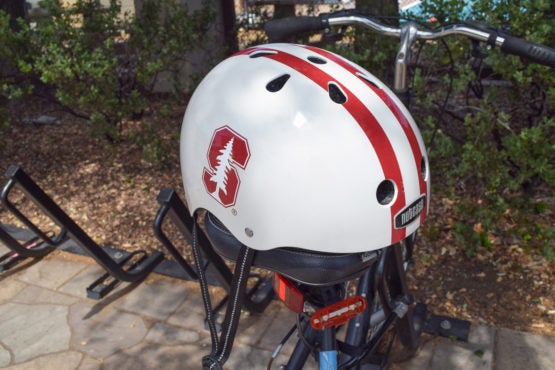Stanford freshmen to receive free bike helmets
In an effort to increase safe bicycling practices among Stanford students, the university will distribute free helmets to nearly 1,800 freshmen in the fall of 2016, thanks to a donation from two Stanford parents.
Stanford freshmen will receive free bicycle helmets when they arrive on campus in the fall of 2016, thanks to a gift from two Stanford parents committed to increasing the safety of bike riding on campus.

The helmets, which will be provided to incoming freshmen in the fall, are the same as those worn by Cardinal intercollegiate athletes for the past year. (Image credit: Kate Chesley)
Russell Siegelman, a Stanford parent who also lectures in the Graduate School of Business, is an avid cyclist who has suffered brain trauma and experienced a catastrophic bike accident. As a result, he and his wife, Beth, have become advocates for wearing bike helmets. They decided to give away helmets to an estimated 1,800 new students to create change in the bicycle culture on campus by making wearing helmets the norm.
In talks with his son, students and others, Siegelman learned that young adults often forgo wearing helmets because, among other reasons, they worry that doing so is “uncool.” At Stanford, only an estimated 20 percent of undergraduate students report wearing helmets when pedaling to and from classes and events.
Bicycle friendly campus
There are about 13,000 bikes on the Stanford campus each day. Stanford is considered a bicycle friendly campus with 12 miles of bike lanes and more than 19,000 bike parking spaces. The university has been designated a Platinum Level Bicycle Friendly University by the League of American Bicyclists.
Still, despite the university’s myriad of programs, crashes happen – 626 over the past 10 years – some with unfortunate consequences. So, to help the university better instill safe riding habits among undergraduate students, the Siegelmans partnered with Ariadne Scott, the Stanford bicycle program coordinator, to make wearing bicycle helmets the norm. The helmets new students will receive at New Student Orientation in September are white with a red Stanford “S” with tree emblazoned on the side.
The helmets are the same as those worn by Cardinal intercollegiate athletes for the past year. The Department of Athletics, working with a supportive donor, distributed bike helmets to its 900 athletes, some of whom were required to wear them by coaches. The helmets were designed by the student athletes themselves, according to Patrick Dunkley, deputy athletic director.
“In part, our objective was increasing safety for student athletes and instilling in them good riding habits,” he said. “But we were also hoping our athletes would be seen as role models by other students.”
To some degree, Dunkley said the specially designed helmets have changed the habits of student athletes. But changing the habits of an entire campus may be more challenging.
“Beth and I hope that by providing students free, cool bike helmets that we can bring about a change in the helmet-wearing culture at Stanford,” Siegelman said. “Changing behavior is hard. Most students probably already know that it is safe and sensible to wear a helmet, but most still don’t wear one.”
Scott, whose office promotes bike use and safety university-wide, said that statistics cited by Stanford trauma surgeons suggest 98 percent of the people who suffer head injuries from bicycle accidents were not wearing a helmet. Wearing a helmet, on the other hand, reduces the risk of head injury by 50 percent, according to statistics from the Insurance Institute for Highway Safety.
Feeling invincible
The challenge, Scott said, is that college-age students see themselves as invincible. As a result, they often engage in such dangerous behavior as ignoring stop signs, texting or eating while riding, traveling without a light after dark and having both ears covered with music earbuds. Stanford surveys show that students complain helmets flatten their hair and that they believe they are good riders and will be able to avoid a crash.
Siegelman knows better.
“I had an accident and hit the pavement,” Siegelman said. “I was by myself, and there was no car involved. I just got stung by a bee, took one hand off of the handle bar and a fraction of a second later I was on the ground. I had no idea what happened – it was over so fast. My head directly hit the road and it cracked my helmet. I kept that helmet to show my kids. If I had not had a helmet on I am sure my life would have changed.”
The accident reminded Siegelman of his own brain surgery unrelated to biking.
“I was in rehab for months after,” he said. “In the rehab clinic, I met people who had traumatic brain injuries from bikes and other accidents, and I saw how painful and destructive these can be. A broken bone is one thing. But when your brain is injured, it potentially – and often – changes you permanently.”
He added, “Not wearing a helmet when riding a bike is insane. Beth and I realize that others who have not experienced brain injuries or bike accidents may not realize how serious not wearing a helmet is. We hope that students come to know that they should always wear a helmet when biking. No questions asked, no excuses given.”
